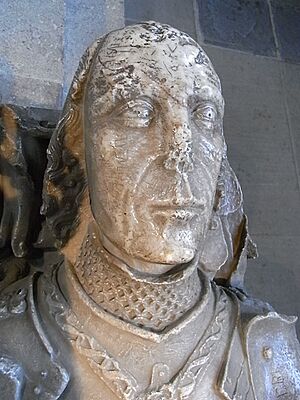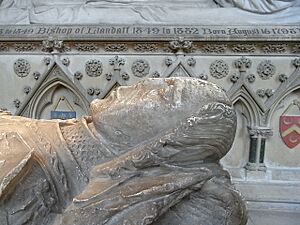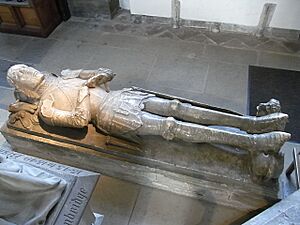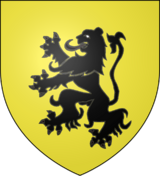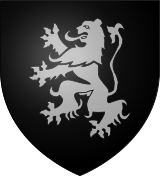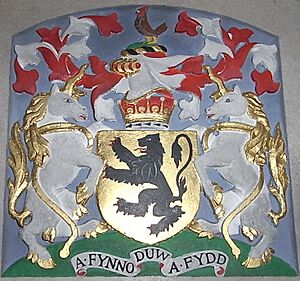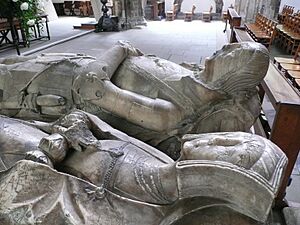Sir David Mathew facts for kids
Sir David Mathew (born Dafydd ap Mathew, 1400–1484) was a famous Welsh Knight. He was the Lord of Llandaff and a special officer called the Seneschal for Llandaff Cathedral. He was also one of the ten most important barons (lords) in Glamorgan, a powerful Marcher Lord who ruled lands on the border. People said he was one of the most important men of his time. He strongly supported the Yorkist side in the Wars of the Roses. After he saved the life of King Edward IV at the Battle of Towton in 1461, the King made him the Grand Standard Bearer of England. This meant he carried the King's flag in battle. King Edward IV also let him add 'Towton' to his family's coat of arms.
Contents
Who Was Sir David Mathew?
Sir David Mathew was the son of a man named Mathew ap Ieuan. He was born around 1400.
His Lands and Power
Sir David was the Lord of Llandaff and the Seneschal of Llandaff Cathedral. He received a large amount of land, about 2,232 acres, from King Henry VI. He also gained land at St Fagans and Pentyrch from William, Earl of Pembroke.
A Hero in Battle
Sir David was a very strong supporter of the Yorkist cause. He was known for his amazing bravery and skill in battle, even when he was quite old. He fought for the White Rose of York. Sir David was a very tall man, said to be about 6 feet 8 inches (2.03 meters) tall.
At the Battle of Towton, which happened on March 29, 1461, Sir David was about sixty years old. During the battle, he saved the life of King Edward IV. Because of this brave act, the King rewarded him by making him the Grand Standard Bearer of England. This was a very important job. King Edward IV also allowed Sir David to add the word "Towton" to his family's crest as a special honor.
Protecting Holy Relics
Sir David was one of the ten most powerful barons in Glamorgan. In 1480, he helped restore the shrine of Saint Teilo. This holy place had been attacked and damaged by pirates. Bishop Marshall gave Sir David St. Teilo's skull, which was placed in a valuable reliquary (a special container for relics). This skull became a family treasure and was kept safe for about 200 years.
How Did Sir David Mathew Die?
A writer named Browne Willis wrote that Sir David was killed in a fight. This happened in Neath, West Glamorgan, and involved some members of the Turberville family.
Mathew Family Symbols (Armorials)
The Mathew family used two different coats of arms. Both show a lion standing on its hind legs, but the colors are different.
Family Coats of Arms
- The Llandaff branch of the family, which was the older line, usually used a black lion on a gold background (Or, a lion rampant sable).
- The Radyr branch, which came from Sir David Mathew's younger brother, usually used a silver lion on a black background (Sable, a lion rampant argent).
It can be a bit confusing because sometimes the Radyr coat of arms was painted on the tomb of Sir Christopher, who was from the Llandaff branch. Also, the Earls Landaff used the Llandaff coat of arms, even though they came from the Radyr branch. Sir David's own tomb does not have any heraldry (coat of arms) to help clear up this confusion. Some believe the Radyr arms were chosen to honor the White Rose symbol of the Yorkist side.
What Was the Family Crest?
The family crest is also a bit confusing. It is described in different ways, such as a "heathcock," "moorcock," or "blackcock." These are all types of birds, like grouse or partridges. On the Earl Landaff memorial, the bird looks more like a farmyard rooster.
However, the statue of Sir David shows most of the bird on his helmet, where his head rests. The head of the bird is missing, but its feet are short and strong. This suggests it was a grouse-type bird, not a rooster with long legs.
Family Motto
The Mathew family's motto is in Welsh: Y Fyn Duw A Fydd. This means "What God wills will be."
Sir David Mathew's Family
Sir David married Wenllian (1396–1470) from Glamorgan, who was the daughter of Sir George Herbert. They had three sons.
His Sons and Their Descendants
- David (born 1425): He was the first son. He married Ann Myddletonn and had a son named Jenkyn Mathew. This David is considered the start of the "Mathews" family line in America. His descendant, Thomas Mathews (born 1660), arrived in Virginia around 1700.
- Reyborn (or "Reinborn," "Rimbron," died 1470): He was the second son and started the Llandaff line of the Mathew family. He married Isabella Denys. Reyborn asked to be buried in a chapel in Bristol. His will also asked for gold and silver items to be placed on the shrines of his relatives, Saint Teilo, Saint Oudoceus, and Saint Dubricius, at Llandaff Cathedral. Reyborn's oldest son was Sir Christopher Mathew (died 1528), whose statue is one of the three Mathew statues still in Llandaff Cathedral. Sir Christopher's son, Miles Mathew, became the High Sheriff of Glamorgan in 1547. A later family member was Admiral Thomas Mathews (died 1751), who built Llandaff Court.
- Thomas (1438–1470): He was the third son. He was in charge of keeping the relics of St. Teilo safe. He married Catherine ferch Morgan and started the Radyr line of the Mathew family. He was also buried in Bristol. When Thomas died in 1470, his lands went to his son William Mathew (1460–1528). King Henry VII made William a knight at the Battle of Bosworth in 1485. Sir William also went with King Henry VIII to the famous Field of the Cloth of Gold meeting in 1520. Sir William's oldest son, Sir George Mathew (1486–1557), became a Member of Parliament for Glamorgan and the High Sheriff of Glamorgan in 1545. The family of the Earls Landaff in Ireland came from this Radyr line.


